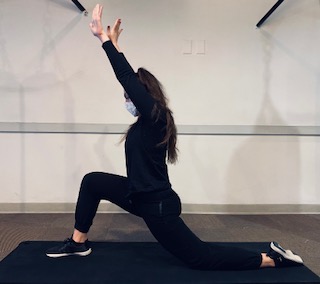 |
| by Amber Yavitz, Front Office Coordinator |
One of the most foundational components of yoga is building an awareness of breath. Yoga instructors guide practitioners through breathing techniques, which are used to help flow through each pose and movement and aid in stabilization of a pose. While most yoga poses and breathing techniques are used for the intention of relaxation and mindfulness, physical therapy also uses breathing techniques to teach postural awareness and emphasize controlled breathing.
If you’re new to yoga, don’t be intimidated by some of the more advanced poses you may have seen! Modifications and variations are given in most yoga classes, especially for people who are not as flexible or experienced, and your physical therapist can always work with you to modify poses that fit within your restrictions. Yoga is an ongoing practice to learn your body and improve movement, and regularly practicing yoga can help with body awareness and clearing one’s mind to center attention. If you have done physical therapy before, chances are you already know more than you think - below are some poses that you may have seen or done before!
Child’s Pose
Child’s pose is a rest pose that is used in yoga to calm and ground the practitioner. Its main benefit is increasing flexibility by creating a gentle stretch for the back and hips, which is a common goal for physical therapy programs for low back and hip pain. Deep breathing in this pose can relax the body, especially after more difficult yoga sequences or exercises.
Warrior One and Two
These standing poses help with balance and focus while opening the hips and chest. By utilizing longer holds, they can also help strengthen the shoulders, legs, and back. Note that the difference between these two poses is the arm position: in Warrior One arms are up, and in Warrior Two arms are opened wide to the side.
 |
| Warrior One |
 |
| Warrior Two |
Sphinx Pose
Sphinx pose is a softer back bend that can stabilize the shoulders and lengthen the abdomen. This is a beginner pose that can prepare the body for more advanced poses later in your practice. This allows the practitioner to keep the pressure off the back while still opening the chest. In physical therapy, Sphinx Pose can be a good way to work on gradual extension in the back until you are ready for an Upward Facing Dog pose.
Low Lunge
The Low Lunge is used in many yoga sequences and there are many variations for different comfort levels. This position stretches the hip flexors and quads, helping to restore range of motion in the hips. Many people are very tight in their hips due to living a sedentary lifestyle and so may require modifications depending on how tight the muscles are.
If you are experiencing an injury, physical therapy and yoga together can work hand in hand to ensure optimal recovery. Once you have graduated from physical therapy, continuing yoga will help the body maintain strength gains, decrease stress, and prolong flexibility.



